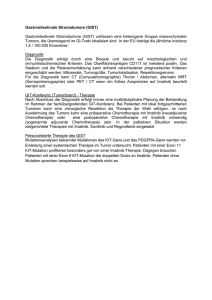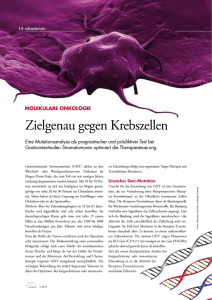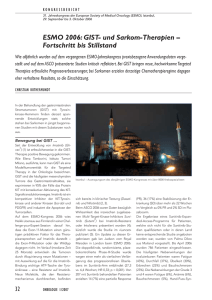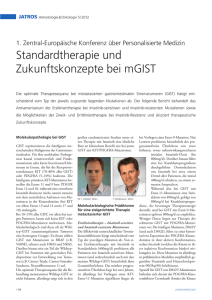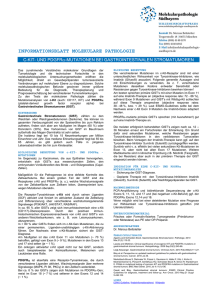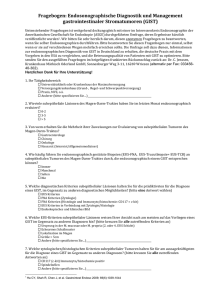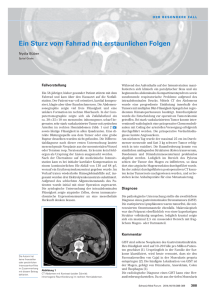PDF,4.3 mb
Werbung
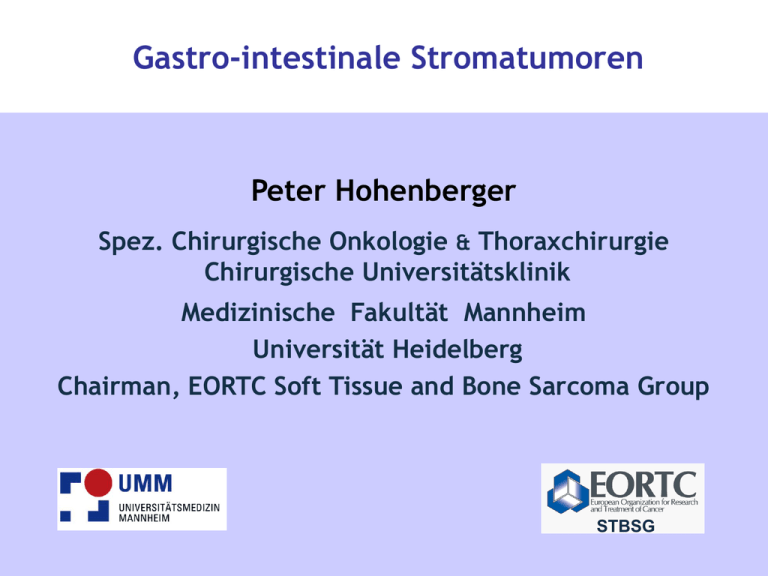
Gastro-intestinale Stromatumoren Peter Hohenberger Spez. Chirurgische Onkologie & Thoraxchirurgie Chirurgische Universitätsklinik Medizinische Fakultät Mannheim Universität Heidelberg Chairman, EORTC Soft Tissue and Bone Sarcoma Group STBSG Pathologische Klassifizierung und neue Therapieansätze • Behandlungsprinzipien für Primärtumoren • Indikation zur adjuvanten Therapie • Indikation zur neoadjuvanten Therapie • Wann ist eine Mutationsanalytik notwendig • Plasmaspiegelbestimmung auch bei GIST ? GIST - Klinische Präsentation – Charakteristische Pathologie Früher: muskulärer Ursprung – Heute: » nicht muskulär » nicht neural » “Stroma Tumoren” pacemaker Zellen Cajal 90% der mesenchymalen Tumoren des Darms sind GIST GIST - Ursprung Cajal Zellen ? Lumen Mucosa Muscularis mucosae Submucosa Muscularis propria Courtesy: R.Feakins, London GIST - Ursprung Cajal Zellen Lumen Mucosa Muscularis mucosae Submucosa Muscularis propria Courtesy: R.Feakins, London Biopsie oft nicht zielführend Mucosa GIST Lokalisation gastrointestinaler Stromatumoren (n=316) 1,9% 60,1% 32,9% 5,1% GIST: Mikroskopische Subtypen spindelzellig n=220 70,1% gemischt n=66 21,0% epitheloidzellig n=28 8,9% Sehr kleine GIST – endoskopische Resektion absolute Ausnahme ! Prinzipien chirurgischer Therapie • Jeder GIST ist potentiell maligne • OP-Prinzipien wie bei Krebsoperation • Indikation zur OP : GIST > 2cm • Komplette Resektion (R0) • 1-2 cm Sicherheitsabstand • Keine ausgedehnte Lymphknotendissektion Prinzipien chirurgischer Therapie • Endoskopisch : nein, Wachstum intramural • Laparoskopisch : ja, wenn Prinzipien einer Krebsoperation eingehalten • Problem der Lokalisation • Tumorruptur • Dissemination in der Bauchhöhle vermeiden Resektionausmass: Dünndarm Resektionsausmass am Magen Was können wir aus chirurgischen Daten lernen ? Tumor ruptur Operative Therapie von Primärtumoren (n=486, MA/BN/B) 27 Pat. mit Tumorruptur / Perforation 3 pat. mit M1 disease + Perforation 18 primäre Tumorperforation 2 Tumorruptur nach stumpfen Bauchtrauma 4 Tumorruptur während Resektion 1 Patient rezidivfrei nach 82 Monaten ! 4/5 Patienten unter adjuvanter Therapie rezidivfrei alle anderen Patienten (18/19) entwickelten Metastasen Medianes Zeitintervall bis zum Rezidiv : 22 Monate (range, 5-82) Ann.Surg.Oncol 2009; 16,S1: A296 Omentale und peritoneale Metastasen Adjuvante Therapie ? Progressionsfreie Zeit vs. Tumorlast Blanke C, et al. JCO. 2008;26(4):626-632. ACOSOG Z9001 (Closed in April 2007) Placebo Surgery n=644/700 F O L L O W Randomization Imatinib 400 mg x 1 year 1 ° RFS 2 ° OS 5 years or until death Objectives: • Primary: Relapse free survival • Secondary: Overall survival Inclusion criteria: • KIT-positive GIST • > 3 cm • Completely resected DeMatteo et al. Lancet. 2009;373:1097-1104. Treatment / Compliance 713 Patients randomized Imatinib (n=359) Placebo (n=354) 337 received drug 22 did not receive drug 32 not evaluable 345 received drug 9 did not receive drug 33 not evaluable 97 (27.0%) stopped treatment: 87 (24.6%) stopped treatment: 57 (15,9%) due to AEs 1 (<1%) recurrence 15 (4,2%) patient decision 24 (6,7%) other / missing reasons 11 (3,1%) due to AEs 41 (11,6%) recurrence 20 (5,6%) patient decision 15 (4,2%) other / missing reasons Grade 3 or 4 AEs: Grade 3 or 4 AEs: 31,0% (n=104) 18,0% (n=63) DeMatteo et al. Lancet. 2009;373:1097-1104. Z9001: Recurrence-Free Survival DeMatteo et al. Lancet. 2009;373:1097-1104. Recurrence-Free Survival: Tumors > 6 cm and < 10 cm DeMatteo et al. Lancet. 2009;373:1097-1104. Z9001: Recurrence-Free Survival: > 10 cm DeMatteo et al. Lancet. 2009;373:1097-1104. Z9001: Overall Survival Number at Risk DeMatteo et al. Lancet. 2009;373:1097-1104. Recently completed trials of adjuvant imatinib in GIST SSG XVIII-AIO: EORTC 62024: • Trial description • 12 months versus 36 months of Imatinib • Objectives • Primary: relapse-free survival • Inclusion criteria • High-risk GIST • (initially M1) • Patient numbers • 400 randomized • Trial description • 24 months of imatinib Imatinib versus control • Objectives • New Primary: primary: overall survival Time to imatinib failure • Inclusion criteria • Intermediate-risk or high-risk GIST • Patient numbers • 906 900 randomized Press Release: Basel, April 12, 2007 Glivec is indicated for the adjuvant treatment of adult patients after resection of KIT (CD117) positive GIST larger than 3 cm Glivec is indicated for the adjuvant treatment of adult patients who are at significant risk of relapse following resection of KIT (CD117) positive GIST Patients who have a low or very low risk should not be treated GIST-Klassifikation nach Fletcher 2002 Risiko eines aggressiven klinischen Verhaltens sehr niedrig < 2 cm <5/50 HPFs niedrig 2-5 cm <5/50 HPFs mittel < 5 cm 6-10/50 HPFs 5-10 cm <5/50 HPFs > 5 cm >5/50 HPFs > 10 cm jede Mitosezahl jede Grösse >10/50 HPFs hoch Metastasenrisiko bei intestinalen und gastralen GIST (nach Miettinen und Lasota, Sem Diagn Pathol 2006) Gruppe Größe Mitosenzahl Risiko Magen 1 < 2 cm <5/50 HPFs 2 > 2-5 cm <5/50 HPFs 3a > 5-10 cm <5/50 HPFs ø Jej./Ileum Duodenum Rektum ø ø ø sehr niedrig niedrig niedrig niedrig niedrig moderat hoch hoch hoch hoch hoch hoch 3b > 10 cm <5/50 HPFs moderat hoch --------------------------------------------------------------------------------------------------4 < 2 cm >5/50 HPFs ø* hoch* hoch 5 > 2-5 cm 6a > 5-10 cm 6b >5/50 HPFs >5/50 HPFs > 10 cm >5/50 HPFs * Sehr geringe Fallzahl; - keine Fälle moderat hoch hoch hoch hoch hoch Mitotic Index Size Gastric Jejunum/ Ileum Duodenum Rectum ≤ 2cm 0% 0% 0% 0% ≤5 >2 - ≤ 5cm 1.9% per 50HPF 4.3% 8.3% 8.5% >5 - ≤ 10cm 3.6% 24% > 10cm 12% 52% 34% 57% ≤ 2cm 0% 50% No data 54% >2 - ≤ 5cm 16% 73% 50% 52% >5 - ≤ 10cm 55% 85% > 10cm 86% 90% 86% 71% >5 per 50HPF Very low risk Low risk Mitotic Index Size Gastric Jejunum/ Ileum Duodenum Rectum ≤ 2cm 0% 0% 0% 0% ≤5 >2 - ≤ 5cm 1.9% per 50HPF 4.3% 8.3% 8.5% >5 - ≤ 10cm 3.6% 24% > 10cm 12% 52% 34% 57% ≤ 2cm 0% 50% No data 54% >2 - ≤ 5cm 16% 73% 50% 52% >5 - ≤ 10cm 55% 85% > 10cm 86% 90% 86% 71% >5 per 50HPF High risk Mitotic Index Size Gastric Jejunum/ Ileum Duodenum Rectum ≤ 2cm 0% 0% 0% 0% ≤5 >2 - ≤ 5cm 1.9% per 50HPF 4.3% 8.3% 8.5% >5 - ≤ 10cm 3.6% 24% > 10cm 12% 52% 34% 57% ≤ 2cm 0% 50% No data 54% >2 - ≤ 5cm 16% 73% 50% 52% >5 - ≤ 10cm 55% 85% > 10cm 86% 90% 86% 71% >5 per 50HPF Intermediate risk Discussion required Mitotic Index Size Gastric Jejunum/ Ileum Duodenum Rectum ≤ 2cm 0% 0% 0% 0% ≤5 >2 - ≤ 5cm 1.9% per 50HPF 4.3% 8.3% 8.5% >5 - ≤ 10cm 3.6% 24% > 10cm 12% 52% 34% 57% ≤ 2cm 0% 50% No data 54% >2 - ≤ 5cm 16% 73% 50% 52% >5 - ≤ 10cm 55% 85% > 10cm 86% 90% 86% 71% >5 per 50HPF Very low risk Intermediate risk Low risk High risk Praktischer Vorschlag Indikation: Patienten mit hohem Risiko - nach Fletcher, Miettinen oder Joensuu Keine Indikation: Patienten mit „low‟ / „very low‟ Risiko - nach Fletcher, Miettinen or Joensuu Diskussion mit dem Patienten mit „intermediate risk‟ Indikation bei Patienten mit Tumorruptur Imatinib unwirksam bei NF-1, KIT exon 17 Mutation, D842V PDGFRa Mutation Mutations-analyse bei Hoch-Risiko Patienten Pflicht Neoadjuvante Therapie Multiviscerale Resektion notwendig : Magen, Milz+ Zwerchfell Geplant : totale Gastrektomie, Pankreas, Splenektomie + Zwerchfellresektion Nach 6 Monaten imatinib 400 mg Apollon trial PET prior to therapy PET after imatinib GIST des AEG Staiger World J Surg Oncol 2008; 4: 37 GIST des AEG after 6 months imatinib Staiger World J Surg Oncol 2008; 4: 37 Merendin - Rekonstruction Merendino KA, Dillard DH. Ann Surg. 1955; 142: 486-506 Specimen and postop. situation Staiger World J Surg Oncol 2008; 4: 37 Neoadjuvant studies of imatinib Trial N Phase Regimen Setting Primary End Point Statusa RTOG S-01321 63 2 Imatinib 600 mg/d Neoadjuvant/ adjuvant PFS Enrollment completed MDACC ID03-00232 48b 2 Imatinib 300 mg twice daily Neoadjuvant/a djuvant DFS Recruiting Apollon CSTI571 BDE43 46 2 Imatinib 400 mg/d Neoadjuvant DFS Recruiting DFS, disease-free survival; EORTC, European Organisation for Research and Treatment of Cancer; GSS, GIST-specific survival; MDACC, M.D. Anderson Cancer Center; OS, overall survival; RFS, recurrence-free survival; RTOG, Radiation Therapy Oncology Group; SSG, Scandinavian Sarcoma Group. 1. ClinicalTrials.gov. Accessed July 31, 2008. 2. Trent J. http://utm-ext01a.mdacc.tmc.edu/dept/prot/clinicaltrialswp.nsf/index/id03-0023. RTOG 0132: neoadjuvant imatinib for primary GIST • 30 patients • Median tumor size 9 cm (5-25 cm) • GE junction, duodenal, rectal • R0 resection 77% • Median follow-up 3 years Eisenberg et al. J Surg Oncol. 2009; 99(1):42-7. RTOG 0132: PFS Progression-Free Survival (%) 100 // / 75 // / / 50 25 Failed 11 0 0 Patients at Risk Primary / / 30 Total 30 2-year Estimate (95% CI) 82.7% (68.9, 96.6) 1 2 Years after Registration 27 19 3 10 Eisenberg, J Surg Oncol. 2009; 99(1):42-7 RTOG 0132: Overall Survival, Primary GIST Overall Survival (%) 100 / / / /// // // / // 75 50 25 0 Dead 6 0 Patients at Risk Primary 30 Total 30 1 2-year Estimate (95% CI) 93.3% (84.4, 100.0) 2 3 Years after Registration 29 22 13 Eisenberg et al. J Surg Oncol. 2009; 99(1):42-7. Systemische Therapie bei M1 Therapiestop nach 1 Jahr Blay JY et al. J Clin Oncol. 2007;25(9):1107-1113. Therapiestop nach 3 Jahren 1.0 0.9 0.8 CONT group 1 evts / 24 patients 1-year PFS: 91.7% (CI95 = 76.0 - 100.0) Probability 0.7 0.6 0.5 0.4 Log-rank test : p = 0.0013 0.3 0.2 STOP group 12 evts / 25 patients 1-year PFS: 20.2% (CI95 = 0.0 - 43.7) 0.1 0.0 0 3 6 9 12 15 18 21 24 Months Le Cesne et al., ASCO 2007, # 10005 No survival disadvantage after stop BFR14 : Survie globale des randomisés à 1 an 1.0 0.9 Probabilité de survie 0.8 0.7 STOP group 3 décès / 32 patients 0.6 CONT group 2 décès / 26 patients 0.5 0.4 0.3 5 décès / 58 patients 0.2 Médiane de suivi : 17.9 mois ; IC95 = [15.2 ; 19.4] Log-rank test : p = 0.70 0.1 0.0 0 6 12 18 24 Délai depuis randomisation à 1 an (mois) 30 36 42 Imatinib-Plasmaspiegel korrelieren mit dem klinischen Benefit von Patienten mit inoperablem/metastasiertem GIST Demetri et al., ASCO-GI 2008, # 3 Imatinib-Plasmaspiegel korrelieren mit dem klinischen Benefit von Patienten mit inoperablem/metastasiertem GIST Ungünstige Konstellation 2ndary KIT mutations in GISTs under treatment with Glivec NH2 NH 2 KIT PDGFRA n=14 n=0 JM Domain (544-588) Tyrosine kinase domain 1 (589-694) V654A T670I, T670E S709F Kinase insert (695-770) D816G, D816E D820E, D820Y, D820G Tyrosine kinase domain 2 (771-924) N822K Y823D COOH COOH Clin Cancer Res. 2006 15;12: 1743 Relevanz der Mutationsanalyse bei GIST • Diagnose von schwach CD117-positiven oder CD117-negativen GIST • prognostische Relevanz – spezifische Mutationstypen haben eine – bessere Prognose (PDGFR Exon 18, Duplikation in KIT Exon 11) oder – schlechtere Prognose (Deletion in KIT Exon 11, Duplikation in KIT Exon 9) • Prädiktion des Therapieansprechens: Exon 11 > Exon 9 > Exon 18 (Punktmutation)/Wildtyp • Optimierung der Imatinibdosis Schlussfolgerung: • Analyse aller klinisch relevanten GISTs bei Primärdiagnose Residualtumor (A) vs. Resektion bei Progress 80 patients Mannheim/Milano Progression-free survival Mussi C et al., Annals of Oncol 2009; July 23rd, 2009 ahead of print Imatinib Follow for PFS & OS Metastatic GIST in response on IM Imatinib + surgery at best response (within 1 yr) Zusammenfassung Einhaltung chirurgischer Standards – Krebsoperation ! Indikation zur adjuvanten Therapie : signifikantes Rezidivrisiko, Ruptur Multiviscerale Resektion von Primärtumoren ist nicht länger ‚Standard of care„ Mutationsanalytik für Patienten mit metastâsiertem GIST und ‚atypische„ GIST für die adjuvante Therapie ! Plasmaspiegel bei Patienten mit diskrepantem Ansprechen im Vgl. zur Mutationsanalytik indiziert. Randomisierte Studie zum Stellenwert der Operation bei Respondern in der M1 Situation
